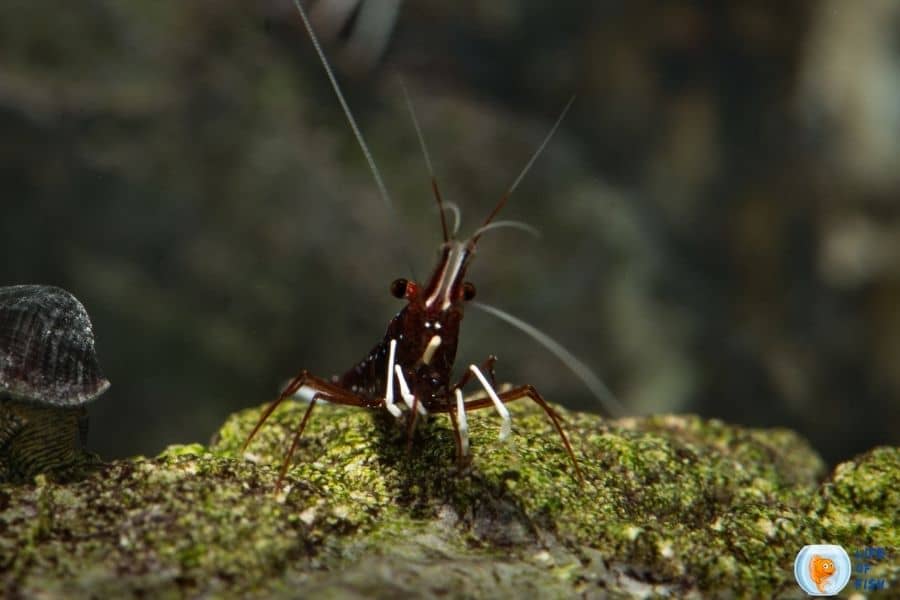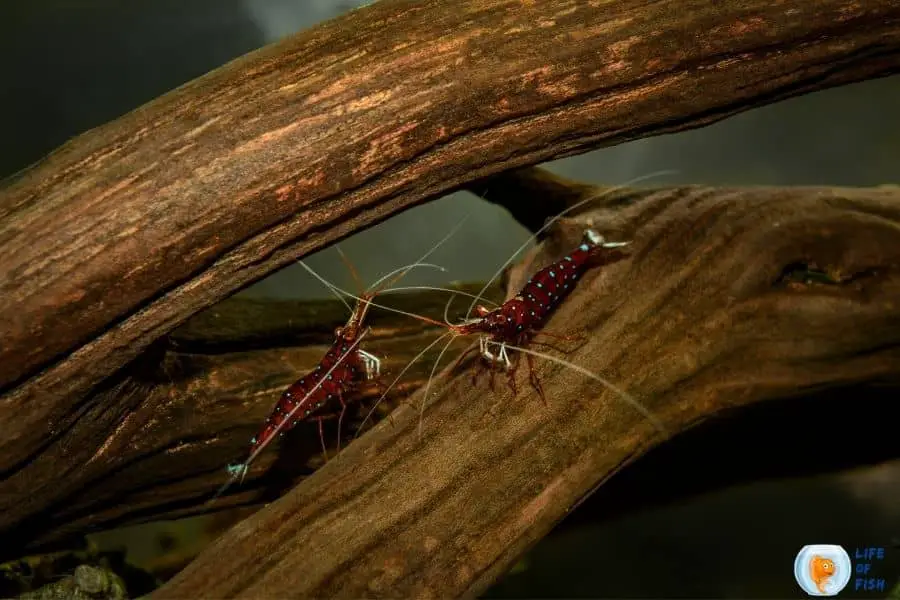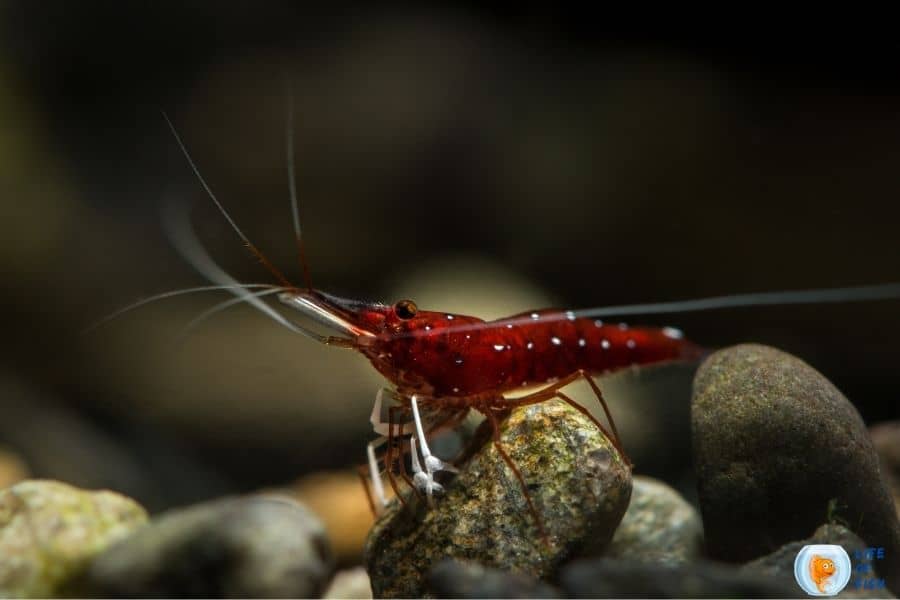Sulawesi shrimp is one of the proud possession in my aquarium. This shrimp is not for beginners. you need some level of experience to keep this shrimp alive. If you like rare species like me and have experience in rare species keeping, this shrimp is for you.
According to my knowledge, only hand full of expert shrimp breeders breed this species of shrimp. So it is not easy to find this organism (maybe not in your local pet store). But, if you found one, this care guide is for you. In this article, you can learn everything about Sulawesi shrimps, their care requirements, and how to breed them.

One look care guide
Jump To
- 1 One look care guide
- 2 What is Sulawesi shrimp?
- 3 How big do they get?
- 4 Is Sulawesi shrimp aggressive?
- 5 Sulawesi shrimp behavior
- 6 Lifespan Sulawesi shrimp
- 7 Sulawesi shrimp care
- 8 Sulawesi shrimp breeding
- 9 Special tips
- 10 How to feed the shrimp?
- 11 What fish can live with Sulawesi shrimp?
- 12 Related questions
| Scientific name | Caridina dennerli |
| Common name | Cardinal Shrimp, White Glove shrimp, Sulawesi shrimp |
| Care level | Difficult |
| Native to | Sulawesi lake system in Indonesia |
| Type | Shrimp |
| Color | Red (different shades) with white spot |
| Tank size | 5-gallon minimum, 10 gallons recommended |
| Preferred temperature | 77 and 86 F |
| Other water parameters | pH – 7.8 – 8.2 General hardness (°GH) – 7 Carbonate hardness (°KH) – 5 Conductance (μS) – 175 Total dissolved solids (ppm) – 87.5 Oxygen (mg/l) – 6.93 |
| Preferred salinity | No salinity, Freshwater species |
| Size of the Sulawesi shrimp | 1.5 – 2.5 cm (~1/2 – 1 inch) |
| Life Span | 1 – 2 years |
| Temperament | Peaceful |
| Recommended tank mates | Sulawesi Dwarf shrimp, Sulawesi Snail |
| Preferred food | Biofilm, algae, spirulina powder, powdered food |
| Feeding frequency | Once per day or once per two days |
| Breeding | Medium |
What is Sulawesi shrimp?
Sulawesi shrimp, commonly known as Cardinal shrimp or white glove shrimp, is a vibrant-colored shrimp species native to Indonesia. Scientifically named Caridina dennerli, these shrimp species were first discovered in two ancient lakes of Indonesia in 2007; The Sulawesi region lake Poso and the five-lake Malili system.
Like other water bodies in the Sulawesi region, the water in these lakes is unique with different parameters. Therefore, Sulawesi shrimps are difficult to care for in aquariums as you have to provide exact water conditions for these species to thrive. Sulawesi shrimp is a small shrimp species that is red in color with white spots.
This exceptional shrimp species is unfortunately listed in the IUCN Red List as an endangered species. Due to water pollution in their native habitats, Sulawesi shrimps are slowly vanishing. Soon, you will not be able to find these species in the wild.
How big do they get?
Unlike other dwarf shrimp species, Sulawesi shrimps are extremely small shrimp species. They grow about half an inch to one inch (1.5 – 2.5 cm, ~1/2 – 1 inch) long.
Because of this small size, they tend to be extremely shy.
Is Sulawesi shrimp aggressive?
No. Sulawesi shrimps are peaceful shrimp species that seem to enjoy the presence of other aquatic animals in the tank.
However, due to their small size, you will have to choose suitable tank mates carefully.
Sulawesi shrimp behavior
As Sulawesi shrimps are a dwarf shrimp species, they show typical dwarf shrimp behavior in aquariums. At first, when first introducing the shrimp to an established aquarium, they tend to hide.
Sulawesi shrimps become extremely shy because of their small size. But, as time goes by, these shrimps get accustomed to the new surroundings and start to behave as usual. These shrimps, like any other dwarf shrimp, prefer to stay in groups. They continuously scavenge rocks, substrate, decorations, and plants for food during the day. Like other dwarf shrimps, Sulawesi shrimps also show social behaviors. They do not seem to care about other species around them and do their job constantly.
These shrimps seem to like rocks more as you may see them scraping more in algae-covered rocks. Once they get used to their surroundings, they get along with other fish, snails, and shrimp well. They seem to prefer companions of different species. Breeders often have reported that these shrimps do their best when introduced to the species of their natural habitats.

Lifespan Sulawesi shrimp
Sadly, like most other dwarf shrimp species, Sulawesi shrimps also have a short life span. They only live for about 1 to 2 years maximum.
Sulawesi shrimp care
Caring for Sulawesi shrimps is considered to be difficult as they need unique water conditions just like their natural habitats. You have to be an expert aquarist to be able to keep these shrimps successfully.
Sulawesi shrimp size
Sulawesi shrimp is a small shrimp species that grows only about 1.5cm to 2.5cm (1/2-1 inches) in length. They are usually smaller than many other dwarf shrimp species.
Sulawesi shrimp tank size
Due to their small size, they can live in a small aquarium of about 5 gallons. But, the recommended tank size for these species is about 10 gallons.
How many Sulawesi shrimp should be kept together?
As Sulawesi shrimps prefer to stay in groups, keeping at least 15 to 20 shrimps together is recommended.
Tank setup
You should create the tank to mimic the natural habitats of these shrimps. Their natural habitats are filled with dark substrate, low light conditions, calm water, and some plantations. You have to recreate this environment for Sulawesi shrimps to avoid stress.
Substrate
Use a dark sandy substrate to the bottom. It should be an inert substrate. Never use an active (buffered) substrate like Amazonia ADA with Sulawesi shrimps as these substrates can lower the pH level, which is not suitable for these shrimps.
Filters
A sound filtration system is needed because these shrimps can not tolerate poor water conditions well. It is better to use a sponge filter as these species are tiny.
Heater
You must add a good quality heater to the aquarium as these shrimps require hot water conditions. They need around 77 – 86 F temperature to thrive. Low water temperatures can stress out these species causing death.
Decorations
Adding porous-type driftwood and rocks is beneficial as algae can grow on these surfaces very quickly. And, Sulawesi shrimps love scavenging algae out of rocks and driftwood.
Plants
Having some plants in your aquarium is also beneficial for the shrimps as they can be a host for the algae as well as the plants can provide oxygen to the aquarium.
Lighting
Sulawesi shrimps prefer low lighting levels. So, lighting should be kept to a minimum level.

Water quality condition
As we said before, Sulawesi shrimps have special water condition requirements than other cardina and neocardina species. Like in their natural habitats, Sulawesi shrimps require higher water temperatures to thrive. Their optimum water temperature is between 77 and 86 F. If the water temperature goes down, they will die due to higher stress levels. Therefore, you MUST buy a good aquarium heater for these species.
Sulawesi shrimps also need alkaline water to thrive. Their preferred pH level is between 7.8 and 8.2. So, you need to check the water parameters consistently to keep optimum water parameters. Tap water may work with Sulawesi shrimp if the parameters of the water are not too extreme. However, we recommend using RO/DI water for these shrimps because of their higher price tag.
Optimum water parameters for these shrimps are as follows. If you use RO/DI water, be sure to remineralize it before adding it to the shrimp tank. Whether you use RO/DI water or tap water, you MUST fully cycle the aquarium before introducing your shrimps. Water changes should be done regularly in small amounts to avoid stress and molting issues of Sulawesi shrimps.
Sulawesi shrimp breeding
The breeding of Sulawesi shrimp is pretty straightforward, just like other dwarf shrimp species. If given optimum water conditions and enough food, you have to do nothing much to breed these shrimps. However, providing optimum water conditions is something one can not do easily.
Sulawesi shrimp male or female identification
Sexing of the Sulawesi shrimp is a quite difficult process as the standard with the other shrimp species does not apply to these shrimps because of their dark shell and small size. Any aquarist couldn’t figure out a way to differentiate male Sulawesi shrimp from female with the naked eye.
The female shrimp doesn’t have a curved, larger abdomen like other dwarf shrimp species. Therefore, both male and female shrimp look much alike to the naked eye. However, the female does have a saddle under the carapace, just like other shrimp species. But, unfortunately, this saddle is not visible either because of its darkened shell.
You need to use special equipment to see this saddle. Only infrared light can reveal this saddle through the shrimp’s body. Other than this method, there is no way to identify male and female shrimp.
Identify pregnant Sulawesi shrimp and pregnancy stages
The pregnancy of Sulawesi shrimp happens just like other shrimp species. However, identifying a pregnant shrimp (berried shrimp) can be quite a difficult process. These shrimps are so tiny and have dark red shells that it is impossible to see their enlarged belly through the naked eye. However, you may identify the pregnant shrimp through an infrared light like the above.
When the female fills up its saddle with eggs, it’s called the ‘berried’ shrimp. Just like other shrimp species, when she is ready to spawn, she molts. This molting will release some chemicals to attract mature males to induce spawning. Once the male and the buried female meet, they immediately start to spawn.
Shrimps reproduce via internal fertilization. Once the shrimp eggs are fertilized, the female carries those eggs inside a body part called the” clutch” until the eggs hatch. The incubation period of the shrimp eggs is around 20 days. After this incubation period, the eggs hatch inside the clutch, and fully grown shrimplets are released from the female’s belly.
how they breed
There are particular concerns regarding these shrimps breeding as they need certain water conditions and the difficulty of sexing the shrimp. Further, Sulawesi shrimps have a low breeding rate and fewer producing than other shrimp types. Other than these issues, the process is the same as other aquarium shrimps.
For successful breeding of Sulawesi shrimps, you have to provide the exact water conditions they prefer. Sulawesi shrimps prefer hot and alkaline water conditions. If you fail to imitate their desired conditions, they will get stressed and will not breed. Although sexing of Sulawesi shrimps is hard, you will have to use a piece of infrared light equipment and identify male and female shrimp for breeding.
You will have to keep a larger group of both male and female shrimps together for successful breeding. You should choose a well-established aquarium with enough biofilm to feed the shrimplets until they grow up. Tiny shrimp babies can not feed anything other than biofilm. And also, before the female shrimp release the fry, remove any fish or other species that may prey on shrimplets.
As these shrimps reproduce a small number of babies, we have to save the babies from predators. Do not forget to replace the filter with a sponge filter because the shrimplets may suck up into the filter once born. If you ensure these conditions are met, your Sulawesi shrimp will breed without any hassle. You just have to wait until they are ready to reproduce.

How many babies do Sulawesi shrimp have?
Sulawesi shrimps lay only a few eggs because these are tiny shrimps. They usually produce about 15 shrimplets in one spawning season.
Sulawesi shrimp fry care
There is not much you can do to care for the fry other than providing ideal water conditions and safety from predators and filtration. You will have to remove other species from the aquarium for the time being because they may feed on the shrimplets as they are so small. The filtration system should be replaced with a sponge filter to avoid sucking up the babies from the filter.
Shrimplets can not feed anything other than biofilm in the first few days of their life. So, feeding them isn’t necessary until they become juveniles. Then, you can provide them with supplements and powdered fish food for some time. Slowly introduce them to natural food as they grow up.
Special tips
Sulawesi shrimps are delicate and expensive shrimp species. So, you have to be extra careful with water parameters. Therefore, it is recommended to use RO/DI water with remineralizers for these shrimp. When using any medication or aquarium fish product, always check for the ingredients of that product. Shrimps are fragile species.
They can not tolerate some ingredients used to treat fish. Copper is toxic to these species. So, you MUST not use any product containing copper in any form as an ingredient.
How to feed the shrimp?
As these are small shrimp species, feeding is unnecessary if you keep them in a densely planted, well-established aquarium. However, if you feel that the biofilm in your tank is not enough for the shrimps, you can feed them once per day or two days. You should feed them with powdered food like spirulina powder because of their small size.
You should only feed the amount they can eat within 2 to 3 hours. Overfeeding is not recommended because it can lead to the death of the shrimp.
What fish can live with Sulawesi shrimp?
Sulawesi shrimps are peaceful shrimp species that can get along with any aquarium creatures. However, you have to be careful while choosing compatible tank mates because of their water condition requirements. Their unique water parameters are not compatible with many aquarium species. So, you will have to stick with aquatic animals that come from their exact origin. One such compatible tank mate is the Sulawesi snail. Sulawesi dwarf shrimp is also a good choice.

Related questions
Are Sulawesi shrimp easy to keep?
No. Sulawesi shrimp are not easy to keep. You will have to have expert-level knowledge to keep these species in captivity successfully. Therefore, Sulawesi shrimps are not recommended for beginners.
Can Sulawesi shrimp live with neocaridina?
No. Sulawesi shrimps can not live with neocardina shrimp species. The required water condition levels are different for both species. Sulawesi shrimps need higher pH levels and hot temperatures in their habitats which neocardina species can not tolerate. So, they can not live together.
Are Sulawesi shrimp endangered?
Yes. These exceptional shrimp species are unfortunately listed in the IUCN Red List as endangered species. Due to water pollution in their native habitats, Sulawesi shrimps are slowly vanishing. Soon, you will not be able to find these species in the wild.
Read Next: Blue Dream Shrimp (Neocaridina Davidi) Ultimate Care Guide
